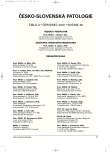Nerve Sheath Myxoma with Bidirectional Schwannomatous and Perineural Differentiation
Authors:
M. Zámečník; T. Sedláček
Authors‘ workplace:
Medicyt, s. r. o., laboratory Trenčín, Slovak Republic
Published in:
Čes.-slov. Patol., 46, 2010, No. 3, p. 73-76
Category:
Overview
Prezentovaný je prípad myxómu nervového púzdra u 70-ročnej pacientky v okcipitálnej oblasti. Tumor mal typickú lobulárnu a myxoidnú morfológiu tejto zriedkavej jednotky. Neobvyklá bola difúzna koexpresia markerov Schwannových buniek S100 proteinu a GFAP a perineurálnych markerov EMA a claudin-1. CD34+ fibroblastické bunky boli málo početné a nervové axóny neboli v tumore nájdené. Diskutovaná je klinická patológia a histogenéza lézie.
Kľúčové slová:
myxóm nervového púzdra – perineurióm – schwannóm – epitelový membránový antigén – S100 protein
Sources
1. Allen P.W., Dymock R.B., MacCormac L.B.: Superficial angiomyxoma with and without epithelial components. Report of 30 tumors in 28 patients. Am. J. Surg. Pathol. 12, 1988, p. 519–30.
2. Argenyi Z.B., LeBoit P.E., Santa Cruz D., et al.: Nerve sheath myxoma (neurothekeoma) of the skin: light microscopic and immunohistochemical reappraisal of the cellular variant. J. Cutan. Pathol. 20, 1993, p. 294–303.
3. Erlandson R.A.: The enigmatic perineurial cell and its participation in tumors and in tumorlike entities. Ultrastruct. Pathol. 15, 1991, p. 335–51.
4. Feany M.B., Anthony D.C., Fletcher C.D.: Nerve sheath tumours with hybrid features of neurofibroma and schwannoma: a conceptual challenge. Histopathology 32, 1998, p. 405-10.
5. Fetsch J.F., Laskin W.B., Hallman J.R., et al.: Neurothekeoma: an analysis of 178 tumors with detailed immunohistochemical data and long-term patient follow-up information. Am. J. Surg. Pathol. 31, 2007, p. 1103–14.
6. Fetsch J.F., Laskin W.B., Miettinen M.: Nerve sheath myxoma: a clinicopathologic and immunohistochemical analysis of 57 morphologically distinctive, S-100 protein- and GFAP-positive, myxoid peripheral nerve sheath tumors with a predilection for the extremities and a high local recurrence rate. Am. J. Surg. Pathol. 29, 2005, p. 1615–24.
7. Fletcher C.D., Davies S.E.: Benign plexiform (multinodular) schwannoma: a rare tumour unassociated with neurofibromatosis. Histopathology 10, 1986, p. 971–80.
8. Folpe A.L., Gown A.M.: Immunohistochemistry for analysis of soft tissue tumors. In: Weiss & Goldblum: Enzinger and Weiss’s Soft Tissue Tumors, 4th ed., Mosby Inc., St. Louis, USA, 2001, p. 199–246
9. Harkin J.C., Reed R.J.: Solitary benign nerve sheath tumors. In: Firminger HI, ed. Atlas of Tumor Pathology, Tumors of the Peripheral Nervous System, 2nd series.Washington, DC: Armed Forces Institute of Pathology, 1969, p. 60–64.
10. Holden C.A., Wilson-Jones E., MacDonald D.M.: Cutaneous lobular neuromyxoma. Br. J. Dermatol. 106, 1982, p. 211–5.
11. Jaffer S., Ambrosini-Spaltro A., Mancini A.M., et al.: Neurothekeoma and plexiform fibrohistiocytic tumor: mere histologic resemblance or histogenetic relationship? Am. J. Surg. Pathol. 33, 2009, p. 905–13.
12. Kazakov D.V., Pitha J., Sima R., et al.: Hybrid peripheral nerve sheath tumors: Schwannoma-perineurioma and neurofibroma-perineurioma. A report of three cases in extradigital locations. Ann. Diagn. Pathol. 9, 2005, p. 16–23.
13. Kharbanda K., Dinda A.K., Sarkar C., et al.: Cell culture studies on human nerve sheath tumors. Pathology 26, 1994; p. 29–32.
14. King D.T., Barr R.J.: Bizarre cutaneous neurofibromas. J. Cutan. Pathol. 7, 1980, p. 21-31.
15. Lazarus S., Trombetta L.: Ultrastructural identification of a benign perineurial cell tumor. Cancer 41, 1978; p. 1823–1829.
16. Michal M., Kazakov D.V., Belousova I., et al.: A benign neoplasm with histopathological features of both schwannoma and retiform perineurioma (benign schwannoma-perineurioma): a report of six cases of a distinctive soft tissue tumor with a predilection for the fingers. Virchows Arch. 445, 2004, p. 347–53.
17. Pal L., Bansal K., Behari S., et al.: Intracranial neurothekeoma: a rare parenchymal nerve sheath myxoma of the middle cranial fossa. Clin. Neuropathol. 21, 2002, p. 47–51.
18. Papadopoulos E.J., Cohen P.R., Hebert A.A.: Neurothekeoma: report of a case in an infant and review of the literature. J. Am. Acad. Dermatol. 50, 2004, p. 129–34.
19. Pulitzer D.R., Reed R.J.: Nerve-sheath myxoma (perineurial myxoma). Am. J. Dermatopathol. 7, 1985, p. 409–21.
20. Shelekhova K.V., Danilova A.B., Michal M., et al.: Hybrid neurofibroma-perineurioma: an additional example of an extradigital tumor. Ann. Diagn. Pathol. 12, 2008, p. 233–4.
21. Schortinghuis J., Hille J.J., Singh S.: Intraoral myxoid nerve sheath tumour. Oral. Dis. 7, 2001, p. 196–9.
22. Webb JN.: The histogenesis of nerve sheath myxoma: report of a case with electron microscopy. J. Pathol. 127, 1979, p. 35–7.
23. Wong B.Y., Hui Y., Lam K.Y., Wei W.I.: Neurothekeoma of the paranasal sinuses in a 3-year-old boy. Int. J. Pediatr. Otorhinolaryngol. 62, 2002, p. 69–73.
24. Woo E.K., Lim T.K., Tan S.H.: Neurothekeomas of the upper limb: case series and clinicopathological review. Hand Surg. 10, 2005; p. 311–7.
25. Zamecnik M., Michal M.: Perineurial cell differentiation in neurofibromas. Report of eight cases including a case with composite perineurioma-neurofibroma features. Pathol. Res. Pract. 197, 2001, p. 537–44.
Labels
Anatomical pathology Forensic medical examiner ToxicologyArticle was published in
Czecho-Slovak Pathology

2010 Issue 3
Most read in this issue
- Ovarian Carcinoma: Current Diagnostic Principles
- Autosomal Dominant Polycystic Kidney Disease in the Fetus with Seemingly Negative Family History. A Case Report
- Autoimmune Pancreatitis with Biliary Tree and Liver Involvement as a Part of IgG4-related Autoimmune Sclerosing Disease. Case Report
- False Negative PAP test? Cytopathologist as a Member of Expert Group in Case of Late Diagnosis of Cervical Cancer
